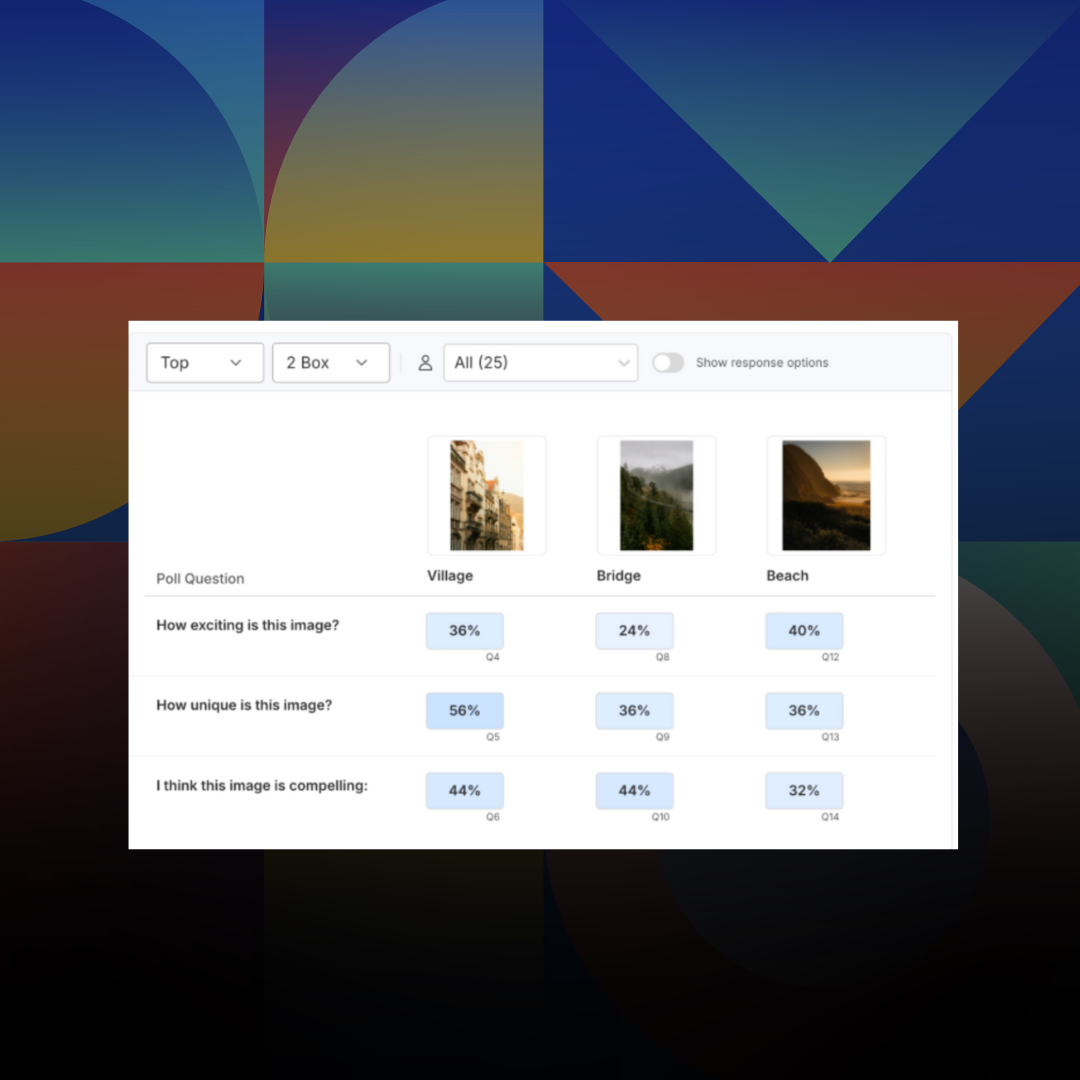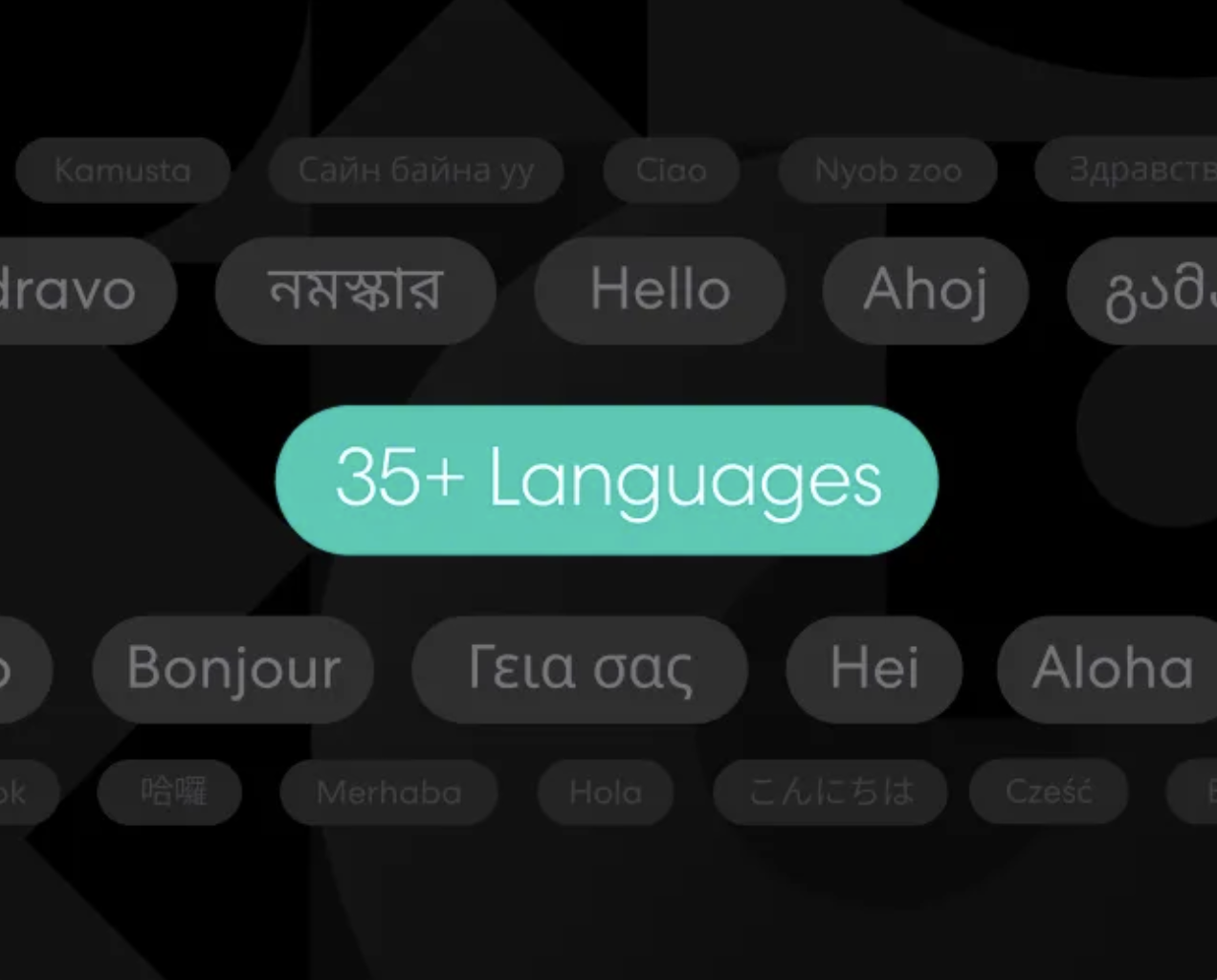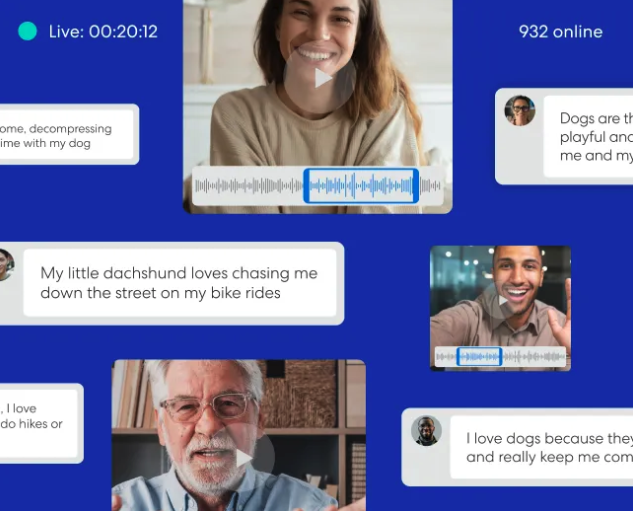
Research 101
Introducing: Poll Comparison - Streamline Concept Testing and Make Better Decisions Faster
Emmet Hennessy
November 24, 2025
Market Research
Articles

Research 101
Introducing: Poll Comparison - Streamline Concept Testing and Make Better Decisions Faster
Emmet Hennessy
November 24, 2025
Market Research
Articles

AI
Purpose-Built for Research AI is Here - a Letter from the CPO
Jessica Dubin
October 21, 2025
Market Research
Articles

AI
Purpose-Built for Research AI is Here - a Letter from the CPO
Jessica Dubin
October 21, 2025
Market Research
Articles

Advanced Research
Unlock Agile Global Insights: Using Remesh Multi-Language Conversations for Research Across Audiences
Customer Success Team
October 14, 2025
Market Research
Articles

Advanced Research
Unlock Agile Global Insights: Using Remesh Multi-Language Conversations for Research Across Audiences
Customer Success Team
October 14, 2025
Market Research
Articles

AI
The Prompt Is the New Moderator Guide
Anthony Lam
September 16, 2025
Market Research
Articles

AI
The Prompt Is the New Moderator Guide
Anthony Lam
September 16, 2025
Market Research
Articles

AI
Building an AI-Ready Research Stack: Beyond Data Preparation
Anthony Lam
September 9, 2025
Market Research
Articles

AI
Building an AI-Ready Research Stack: Beyond Data Preparation
Anthony Lam
September 9, 2025
Market Research
Articles

AI
Agentic AI for Research: A Practical Primer
Dan Reich
September 2, 2025
Market Research
Articles

AI
Agentic AI for Research: A Practical Primer
Dan Reich
September 2, 2025
Market Research
Articles

Advanced Research
Webinar Recap: Unlocking Depth at Scale - Remesh Video for Researchers
Customer Success Team
August 5, 2025
Market Research
Webinars

Advanced Research
Webinar Recap: Unlocking Depth at Scale - Remesh Video for Researchers
Customer Success Team
August 5, 2025
Market Research
Webinars

Transparency in AI: How Remesh Builds Trust Through Responsible Implementation
Ross Coudeyras
July 21, 2025
Articles

Transparency in AI: How Remesh Builds Trust Through Responsible Implementation
Ross Coudeyras
July 21, 2025
Articles

Advanced Research
Webinar Recap: Turning Employee Engagement Insights into Action with Remesh
Customer Success Team
June 16, 2025
Employee Research
Articles

Advanced Research
Webinar Recap: Turning Employee Engagement Insights into Action with Remesh
Customer Success Team
June 16, 2025
Employee Research
Articles
Overcoming Challenges in CPG Market Research
AI enhances CPG market research, tackling smart consumer challenges and rapid trend shifts. Explore how tools like Remesh help researchers gather honest feedback, spot emerging trends, and deliver actionable insights at unprecedented speed and scale.



Imagine an explorer in a vast, ever-changing maze. The walls shift daily, carefully mapped paths suddenly lead to dead ends, and the trusty compass spins wildly, pointing in a new direction with each glance. Welcome to the world of CPG market research.
CPG market researchers aren't just explorers - they're guides for entire companies. Colleagues in product development, marketing, and sales rely on their expertise to find the way forward. But navigation becomes challenging when the terrain constantly evolves.
Challenges in CPG market research
One of the biggest challenges in CPG research is that consumers have become increasingly adept at understanding the research process. Consumers are simply too smart. They can anticipate questions and often provide answers they believe are desired. For example, in a focus group with moms, many are likely to claim they don't give their kids sugar. It's natural—people want to present the best versions of themselves. But while this is a very human tendency, it also makes uncovering genuine insights a real challenge.
The speed at which trends change presents another challenge. Previously, a trend might have lasted for years. Now, these reference points shift almost monthly.
"There was a time when we were focused on low fat. We ran with low fat for about five years," says Kathy Guzmán Galloway, CEO of The Clarity Wizard, a consultancy specializing in brand positioning, consumer insights, and strategy for CPG brands. "But how long did we talk about turmeric? Like, six months. Then we moved on." In a culture where consumers are constantly moving on to the bigger and better thing, researchers can only try to keep pace.
However, this rush to produce quick and current insights can lead to a critical oversight. Clarity in defining research objectives is crucial for effective CPG market research.
"The biggest challenge is agreeing on the business question," says Jennifer Pembroke Johnson of Insights 4 Good, which provides fractional insights leadership, coaching, and expertise to global brands. She emphasizes the importance of having a clear direction before starting any research. The temptation to rush into data collection without a well-defined goal can be strong. But as Jennifer warns, "If you drive fast into a wall, you really haven't gotten anywhere." This metaphor underscores the point that efficiency in research is meaningless if you're not addressing the right questions from the start.
How to overcome challenges in CPG market research
One way to understand today's smart consumers better is by spending more time with them. Instead of relying on yearly studies or focus groups, ongoing conversations work better. This constant contact helps researchers spot when consumers might be saying what they think researchers want to hear.
Understanding why people make certain choices often means digging deeper into their thoughts and feelings. This helps uncover truthful insights, even when consumers might not be fully open.
To gain clarity amid rapidly evolving trends, a learning plan can be a valuable tool for researchers. This plan starts with a workshop where people from different departments come together. They talk about what they think is true about their customers. This process uncovers assumptions that may not be based on facts. The next step is to check if these ideas are true. However, this approach takes time. A full learning plan might take a year to finish. But it helps companies keep learning about their customers all the time.
While these methods are effective, the fast pace of change in consumer trends demands even quicker insights. Researchers need ways to process large amounts of data rapidly and spot patterns that humans might miss. This is where new technology comes in. Artificial Intelligence (AI) is changing how researchers tackle these challenges, offering speed and depth that traditional methods can't match - more on that later.
Read Next: AI in Market Research
The importance of a holistic approach
When addressing challenges in CPG market research, it's crucial not to focus too much on any single aspect. "Over-rotating", as Jennifer puts it, on one type of research or metric can lead to a narrow view of success. For instance, relying solely on concept testing scores for innovation doesn't tell the whole story. Consider the bigger picture, including:
- Understanding the business environment
- Pricing strategy
- The core brand
A product might score well in tests but still fail if other factors aren't considered.
Real-world conditions play a significant role. Consumers have short attention spans and shop in different ways now which affects how products are perceived on shelves, both in physical stores and online. They also need to consider various sales channels - retail stores, online platforms, and direct-to-consumer options.
Pricing is another crucial factor. Companies need to consider not just their own profit goals, but also how their pricing fits within the overall market. This broader view helps identify potential challenges a product might face in the marketplace.
The key is to align all research efforts with the company's main goals. Different parts of a company often work separately, focusing on their own research. But for the best results, all this research should work together towards a common objective.
AI in CPG market research
To achieve a truly holistic approach in CPG market research that avoids human oversight, companies are increasingly turning to Artificial Intelligence (AI). AI-powered tools like Remesh offer a comprehensive solution that addresses multiple challenges in CPG research, from capturing complex consumer behaviors to keeping up with rapidly changing trends.
For instance, Remesh's anonymity feature tackles the "smart consumer" issue. When people know their answers are anonymous, they feel safe sharing their true thoughts. This leads to more honest feedback about products and brands. This way, researchers get a clearer picture of what consumers really think, not just what they think they should say.
Remesh also helps researchers keep up with fast-changing trends. The platform lets teams talk to thousands of people at once. This speed means researchers can spot new trends as they pop up. They don't have to wait months for results that might be outdated by the time they are collected.
The tool's flexibility helps solve another common problem: unclear research goals. Remesh lets researchers adjust their questions during live sessions. They can dig deeper into unexpected answers or explore new ideas on the spot. This real-time flexibility helps teams refine their research objectives as they go.
Additionally, Remesh analyzes responses in real-time, finding patterns and themes quickly. This deep analysis helps researchers understand not just what consumers do, but why they do it.
CPG companies use Remesh for many types of research. They test new products, check how people feel about their brands, and even try out ad ideas. And the best part? All of this happens faster and with more depth than traditional methods allow.
Crafting narratives from research data
Research yields a wealth of data, but raw numbers alone don't provide much value to other departments. To make a real impact, these findings need to be turned into compelling stories that inspire action.
"Amplifying the storytelling is important," said Jennifer. "We need to give marketers and sales teams the power to act on the information, not just hand off a report."
Effective storytelling focuses on how products make people feel, not just on features. This approach resonates with both consumers and colleagues.
When sharing findings, tailor the story to your audience. Think about how they’ll use the information and how it fits into the company’s overall strategy. Brevity and clarity are key. Instead of starting with pages of methodology or sample size details, focus on delivering the most relevant and impactful information right away.
Empathic storytelling enhances the impact of research findings. Adding elements like quotes or video content can make insights more relatable and memorable. The goal is to create concise, powerful narratives that resonate with your audience’s specific roles and needs.
A common mistake is handing off reports without thinking about how the information will be used. Take a proactive approach by selecting and presenting information in a way that's easy to understand and apply.
While technical details shouldn’t be the focus, keep them available for specific questions. Provide enough substance for your audience to engage with the insights effectively, without overwhelming them with too much information.
By focusing on these techniques, CPG market researchers can ensure their insights inspire action and drive meaningful change within their organizations.
Wrapping up
CPG market research has changed rapidly due to evolving consumer behaviors, advancing technology, and shifting business needs. Continuous learning, diverse research methods, and striving to truly understand consumers enable CPG companies to successfully navigate this complex environment.
Thriving as a CPG market researcher requires balancing careful planning with quick adaptation. Genuine interest in understanding the people behind the numbers drives meaningful insights. Curiosity, adaptability, and a focus on providing value to both consumers and companies are key attributes for success.
CPG market researchers aren't just data gatherers - they're guides. Their insights help entire companies find their way. Mastering CPG market research plays a crucial role in shaping the industry's future. With skill, persistence, and the right approach, success becomes achievable, despite the winding path ahead.
-
Lorem ipsum dolor sit amet, consectetur adipiscing elit. Suspendisse varius enim in eros elementum tristique. Duis cursus, mi quis viverra ornare, eros dolor interdum nulla, ut commodo diam libero vitae erat. Aenean faucibus nibh et justo cursus id rutrum lorem imperdiet. Nunc ut sem vitae risus tristique posuere.
-
Lorem ipsum dolor sit amet, consectetur adipiscing elit. Suspendisse varius enim in eros elementum tristique. Duis cursus, mi quis viverra ornare, eros dolor interdum nulla, ut commodo diam libero vitae erat. Aenean faucibus nibh et justo cursus id rutrum lorem imperdiet. Nunc ut sem vitae risus tristique posuere.
-
More

Introducing: Poll Comparison - Streamline Concept Testing and Make Better Decisions Faster

.png)

.png)
Read More

.png)
.png)
.png)

.png)

.png)
Learn More

.png)
.png)
.png)


Unlock Agile Global Insights: Using Remesh Multi-Language Conversations for Research Across Audiences

.png)

.png)
Read More

.png)
.png)
.png)

.png)

.png)
Learn More

.png)
.png)
.png)
Stay up-to date.
Stay ahead of the curve. Get it all. Or get what suits you. Our 101 material is great if you’re used to working with an agency. Are you a seasoned pro? Sign up to receive just our advanced materials.




